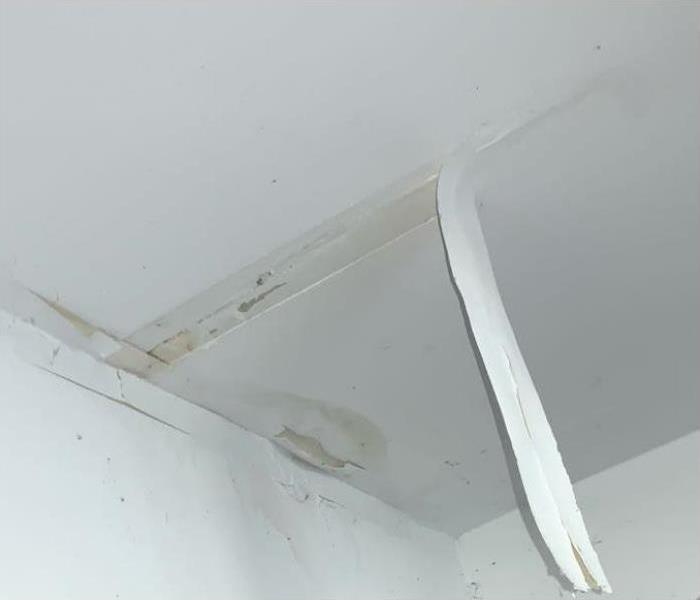5 Actionable Steps To Take When You Have A Water Damaged Ceiling
5/31/2021 (Permalink)
Ceiling water damages deserve undivided attention.
There is nothing more horrifying than sitting in your living room one day, and you notice an unsightly brown projection beginning to peel from your ceiling. You may be wondering why there is a brown spot and how it may have gotten there. After a few Google searches, you realize that your ceiling has been damaged by water. Instead of worrying, start thinking about what action steps to take next.
Although any water damage situation can be stressful, there is good news; if you are reading this post, you likely recognized the sign of ceiling water damage early on. Finding ceiling water damage at early stages allows a homeowner to avert further structural damages.
In this blog post, we will be going over five actionable steps you, as a property owner, should take after finding out that you have a ceiling water damage issue.
Step 1: Address your water damage ceiling situation calmly.
When it comes to water damage repair, we tend to be distressed over the situation and rashly make decisions. Oversee the damage calmly and make an informed decision whether to address it yourself or to seek professional help. It is essential to be aware that quickly addressing a water damage situation can save a property owner from more significant expenses.
Step 2: Find the source of the water damaged ceiling.
There are two primary sources of why a water damaged ceiling may be occurring. The first possible cause of the water damaged ceiling may be the result of a roof leak. A clear sign that you have a roof leak will be clearly shown when your ceiling only gets wet after rainfall.
Another likely cause of a water damaged ceiling is when a property has a pipe brake or defective plumbing pipes. Malfunctioning plumbing piping will lead to water damage when a pipe begins to drip in between the drywall.
Step 3: Remove all water damaged materials.
When you have a water damaged ceiling, remove all the wet materials so that mold will have a less likely chance to grow. There is more to a water damaged ceiling than wet drywall. Inside your wet drywall will also be wet insulation; both materials need to be removed.
Step 4: Check for signs of mold damage.
Whenever there is impending water damage, one of the likely outcomes to watch out for is mold growth. Mold is a type of fungi that can live and thrive anywhere with a little bit of moisture. The professionals at SERVPRO know they have a 48-hour window to mitigate water damage before mold begins to grow. When you find mold, it is essential to contact a professional in mold remediation to ensure a healthy environment in your home.
Step 5: Dry the water damaged ceiling
Once you have isolated and located the source, it is time to dry the damaged area. Water damage professionals use fans and dehumidifiers to dry water-damaged regions thoroughly. You can rent drying equipment at a hardware store, but it is best to hire professionals specializing in water damage repair services. Water restorers have all the necessary drying equipment and disinfectants to ensure your property is ready to be put back "Like it never even happened."
When to call the professionals at SERVPRO
As you learned throughout this blog post, ceiling water damage goes beyond aesthetics: mold can develop and cause severe structural damage. It is best to call the professionals at SERVPRO of East Dayton/Beavercreek at the first sign of ceiling water damage. The professionals will ensure your water damaged ceiling is mitigated correctly and not prone to future mold growth.
The professionals at SERVPRO have witnessed many situations where a property owner has tried to mitigate the water damages on their own, causing more severe issues in the future.
Water damage mitigation is more than just placing drying equipment. The professionals at SERVPRO go through extensive water damage training to ensure all moisture is at proper levels and the property is free from future mold growth.
Contact us today to schedule an inspection when you think or know your property has a water damage issue. We are available 24/7 every day of the year for disaster mitigation!



 24/7 Emergency Service
24/7 Emergency Service